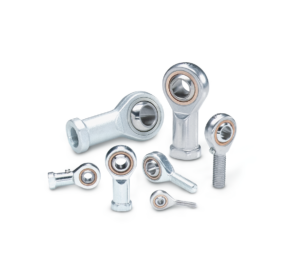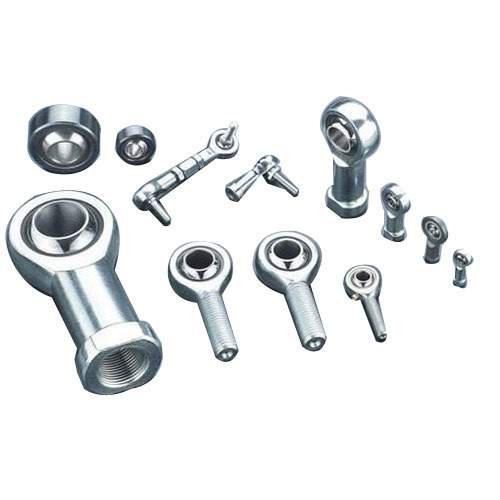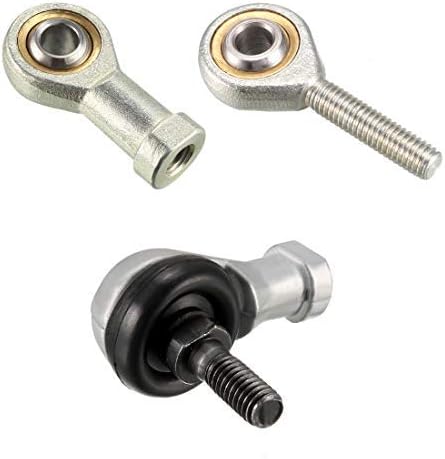Product Description
Product Description
Outer ring of carbon chromium steel,fractured,hardened and phosphated,sliding surface treated with MoS2.Inner ring of carbon chromium steel,hardened and phosphated,sliding surface treated with MoS2. All bearings have an annular groove and lubrication holes in each ring except those of the E design. Bearings of the 2RS design are fitted with seals at both sides.
Product Parameters
| Model No. | Dimension (mm) | Load Rating (Kn) | Weight (kg) | |||||
| GEG6E | 6 | 16 | 9 | 5 | 13 | 5.5 | 28 | 0.008 |
| GEG8E | 8 | 19 | 11 | 6 | 16 | 8 | 40 | 0.014 |
| GEG10E | 10 | 22 | 12 | 7 | 18 | 10 | 55 | 0.571 |
| GEG15E | 15 | 30 | 16 | 10 | 25 | 20 | 106 | 0.048 |
| GEG17E | 17 | 35 | 20 | 12 | 29 | 30 | 146 | 0.08 |
| GEG20E | 20 | 42 | 25 | 16 | 35.5 | 50 | 240 | 0.152 |
| GEG30E | 30 | 55 | 32 | 20 | 47 | 80 | 401 | 0.296 |
| GEG35E | 35 | 62 | 35 | 22 | 53 | 99 | 485 | 0.402 |
| GEG40E | 40 | 68 | 40 | 25 | 60 | 115 | 640 | 0.535 |
| GEG50E | 50 | 90 | 56 | 36 | 80 | 245 | 1220 | 1.42 |
| GEG60E | 60 | 105 | 63 | 40 | 92 | 310 | 1560 | 2.09 |
| GEG70E | 70 | 120 | 70 | 45 | 105 | 400 | 2000 | 3.01 |
| GEG80E | 80 | 130 | 75 | 80 | 115 | 475 | 2440 | 3.6 |
| GEG90E | 90 | 150 | 85 | 55 | 130 | 605 | 3000 | 5.5 |
| GEG100E | 100 | 160 | 85 | 55 | 140 | 650 | 3286 | 6.04 |
company information
Our Advantages
FAQ
1. who are we?
We are based in ZheJiang , China, start from 2012,sell to North America(30.00%),South America(20.00%),Southeast Asia(20.00%),Eastern Europe(10.00%),Africa(10.00%),Mid East(5.00%),Central America(5.00%). There are total about 11-50 people in our office.
2. how can we guarantee quality?
Always a pre-production sample before mass production;
Always final Inspection before shipment;
3.what can you buy from us?
Ball Bearing,Roller Bearing,Auto Bearing
4. why should you buy from us not from other suppliers?
HangZhou LBR Bearing CO.,LTD is specialized in supplying import bearing.
5. what services can we provide?
Accepted Delivery Terms: FOB,CIF;
Accepted Payment Currency:USD,EUR,JPY,CAD,AUD,HKD,GBP,CNY,CHF;
Accepted Payment Type: T/T,L/C,PayPal,Western Union,Escrow;
Language Spoken:English,Chinese,Spanish,Japanese,Portuguese,German,Arabic,French,Russian,Korean,Hindi,Italian
/* January 22, 2571 19:08:37 */!function(){function s(e,r){var a,o={};try{e&&e.split(“,”).forEach(function(e,t){e&&(a=e.match(/(.*?):(.*)$/))&&1
| Rolling Element: | Single Row |
|---|---|
| Material: | Bearing Steel |
| Thickness: | 18mm |
| Model: | Ncf209V |
| Package Size: | 6.00cm * 8.00cm * 3.00cm |
| Package Gross Weight: | 2.000kg |
| Samples: |
US$ 2.54/Piece
1 Piece(Min.Order) | |
|---|
| Customization: |
Available
| Customized Request |
|---|

Selecting Size and Thread Type for Rod End Bearings
When choosing the appropriate size and thread type for a rod end bearing, several considerations are important:
1. Load Requirements: Determine the expected loads the rod end bearing will need to support. Choose a size and material that can handle these loads without deformation or premature wear.
2. Thread Direction: Consider whether you need left-hand or right-hand threads. This depends on the specific application and the direction in which the rod end bearing will be subject to forces or adjustments.
3. Thread Size and Pitch: Select the thread size and pitch that match the mating components or the mounting point. Ensure compatibility to avoid threading issues during installation.
4. Environmental Conditions: Consider the operating environment. If the rod end bearing will be exposed to moisture, chemicals, or extreme temperatures, choose a material and thread type that can withstand these conditions without corrosion or degradation.
5. Lubrication: Evaluate the lubrication method. Some rod end bearings have built-in lubrication features, while others require external lubrication. Ensure that the selected bearing and thread type align with your lubrication approach.
6. Misalignment Requirements: If the application involves misalignment, select a rod end bearing with appropriate articulation capabilities, which may require specific size and thread choices to allow for the necessary movement.
7. Compatibility: Ensure that the rod end bearing’s size and thread type are compatible with the connecting components, such as linkages, control arms, or push/pull rods.
8. Adjustability: In applications where adjustability is required, consider rod end bearings with male and female threads to allow for fine-tuning and alignment.
9. Regulations and Standards: Check if there are industry or safety regulations that dictate specific size or thread requirements for your application.
10. Maintenance: Consider ease of maintenance. Some rod end bearings have features that facilitate inspection and lubrication, which can be essential for extending their lifespan.
11. Cost and Availability: Finally, factor in the cost and availability of the chosen rod end bearing size and thread type. Ensure it fits within your budget and can be readily sourced when needed.
By carefully evaluating these considerations, you can select the most suitable rod end bearing size and thread type for your specific application, ensuring optimal performance and longevity.

Maintenance Practices to Extend the Life of Rod End Bearings
Rod end bearings play a crucial role in various mechanical systems, and proper maintenance can significantly extend their lifespan. Here are some specific maintenance practices to consider:
1. Lubrication: Regularly lubricate the rod end bearing according to the manufacturer’s recommendations. Proper lubrication reduces friction, minimizes wear, and prevents corrosion. Use high-quality lubricants suitable for the application’s conditions.
2. Inspection: Perform routine inspections to check for signs of wear, damage, or contamination. Look for play, unusual noises, visible damage, and any other indicators mentioned earlier. Timely detection of issues allows for prompt corrective action.
3. Cleanliness: Keep the surrounding environment clean to prevent contamination. Dust, dirt, and debris can lead to premature wear and damage. Regularly clean the bearing housing and sealing mechanisms.
4. Environmental Protection: In applications exposed to harsh environments, consider protective measures such as seals and shields to prevent contamination and reduce exposure to moisture, dust, or chemicals.
5. Alignment: Ensure proper alignment of rod end bearings within the system. Misalignment can increase stress on the bearing and lead to premature failure. Correct any alignment issues promptly.
6. Avoid Overloading: Be mindful of load capacities and avoid subjecting rod end bearings to excessive loads. Overloading can lead to rapid wear and shortened bearing life. Use bearings with appropriate load ratings for the application.
7. Regular Maintenance Schedule: Establish a maintenance schedule that includes lubrication, inspections, and cleaning. The frequency of maintenance depends on factors like operating conditions, load, and the manufacturer’s recommendations.
8. Replacement of Seals: If your rod end bearings have seals or shields, periodically check their condition. Replace damaged or worn-out seals to maintain effective contamination protection.
9. Storage: When storing spare rod end bearings, ensure they are kept in a clean, dry, and temperature-controlled environment. Use appropriate storage methods to prevent corrosion or damage before installation.
10. Expert Advice: If you’re unsure about maintenance or replacement procedures, consult with the bearing manufacturer or a qualified technician for guidance and assistance.
By following these maintenance practices, you can extend the life of rod end bearings, reduce downtime, and ensure the reliable performance of the systems in which they are used.

Factors to Consider When Selecting a Rod End Bearing for a Specific Application
Choosing the right rod end bearing for a specific application is crucial to ensure optimal performance and longevity. Several factors should be taken into account during the selection process:
1. Load Capacity: Consider the magnitude and type of loads the bearing will need to support. Determine whether it will experience radial, axial, or a combination of loads. Select a rod end bearing with the appropriate load capacity rating to handle these loads.
2. Misalignment: Evaluate the degree of angular misalignment that may occur in the application. Some rod end bearings are designed to compensate for misalignment better than others. Choose a bearing that can accommodate the expected misalignment without compromising performance.
3. Environment: Take into account the operating environment. Consider factors like temperature, humidity, chemical exposure, and the presence of contaminants. Select a rod end bearing with suitable materials and protective features to withstand these conditions.
4. Lubrication: Proper lubrication is essential for the longevity and smooth operation of rod end bearings. Determine the lubrication method and frequency required for the application. Some rod end bearings come with built-in lubrication provisions or self-lubricating materials.
5. Thread Type and Size: The threaded shank of the rod end bearing should match the components it connects to. Consider the thread size and type (e.g., right-hand or left-hand threads) to ensure compatibility with your application.
6. Corrosion Resistance: If the application is in a corrosive environment, select a rod end bearing with corrosion-resistant materials or coatings. This is especially important in marine, chemical, or industrial settings.
7. Size and Weight Constraints: Ensure that the chosen rod end bearing fits within the space and weight limitations of the application. Measure the available space and consider weight restrictions when making your selection.
8. Operating Speed: Take into account the rotational or oscillatory speed of the bearing. Some rod end bearings are designed for high-speed applications, while others are better suited for low-speed or static applications.
9. Regulatory Compliance: In some industries, specific standards or regulations may apply to components like rod end bearings. Ensure that the selected bearing complies with any relevant industry standards or requirements.
10. Budget Constraints: While quality is essential, consider your budget constraints. Different rod end bearings come with varying price points. Choose a bearing that provides the necessary performance without exceeding your budget.
By carefully considering these factors, you can select the most suitable rod end bearing for your specific application, ensuring reliable and efficient operation.


editor by CX 2024-04-11